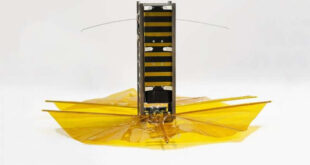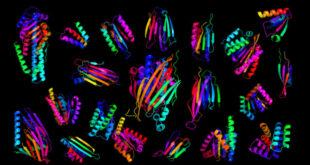The new biofilm-specific vaccine, developed by researchers from the University of Maryland-Baltimore, Northern Arizona University and the University of Zurich, was more than 80% effective in protecting mice from succumbing to Staphylococcus aureus infection.

This digitally-colorized scanning electron microscopic (SEM) image depicts a number of mustard-colored, spheroid-shaped Staphylococcus aureus bacteria that were in the process of escaping their destruction by blue-colored human white blood cells. Magnification – 20,000x. Image credit: National Institute of Allergy and Infectious Diseases.
The diversity of disease caused by Staphylococcus aureus results from differential expression of more than 70 virulence factors.
Virulence factors initiate colonization and growth, mediate damage to the host, and hinder immune response.
Biofilm formation is a powerful virulence factor. Staphylococcus aureus is difficult to eradicate largely because it so readily forms biofilms.
The new vaccine recognizes five different Staphylococcus aureus proteins. Four of these proteins are specific to Staphylococcus aureus biofilms, and one is specific to the pathogen in the planktonic state.
“Effective vaccination would have enormous therapeutic utility in patients undergoing surgery, especially orthopedic and cardiovascular procedures where medical structures or devices are implanted, and in cases of traumatic injury,” said Dr. Janette Harro, a researcher in the Department of Microbial Pathogenesis at the University of Maryland-Baltimore.
In the study, Dr. Harro and colleagues tested the vaccine in mouse and rabbit models of Staphylococcus aureus infection.
More than 80% of immunized mice survived, and two thirds of them cleared the infection, versus less than 10% of controls.
On the 21st day post infection, the surviving animals — both those immunized, and controls — showed no signs of ill health, such as ruffled fur, or other abnormalities of appearance, and all had regained pre-infection weight.
In the rabbit experiments, the scientists injected the pathogen into the tibial bone marrow.
Twenty-four days post infection, nearly two thirds of the immunized rabbits had cleared the infection; none of the controls had done so.
Additionally, while control rabbits had hole-like lesions within the bone, immunized rabbits had smaller lesions or no lesions at all.
“We identified vaccine candidates by screening Staphylococcus aureus proteins with antibodies elicited during chronic Staphylococcus aureus infections in animal models,” Dr. Harro said.
“This method permitted us to select protein targets for vaccination that were both expressed during an infection and were capable of being recognized by the immune response.”
The results were published online this week in the Infection and Immunity, a journal of the American Society for Microbiology.
_____
Janette M. Harro et al. Clearance of Staphylococcus aureus from In Vivo Models of Chronic Infection by Immunization Requires Both Planktonic and Biofilm Antigens. Infection and Immunity, published online November 11, 2019; doi: 10.1128/IAI.00586-19
 #Bizwhiznetwork.com Innovation ΛI |Technology News
#Bizwhiznetwork.com Innovation ΛI |Technology News



